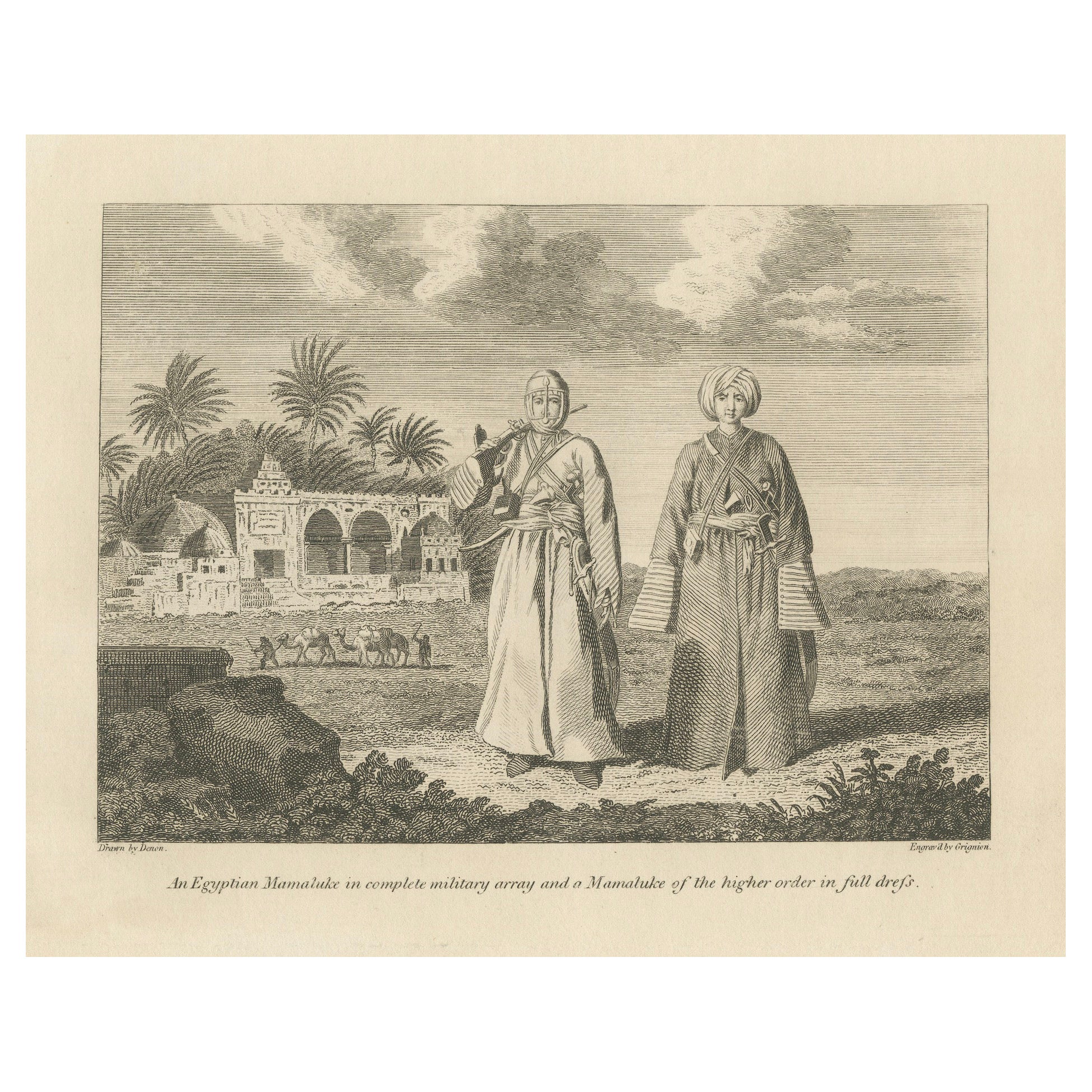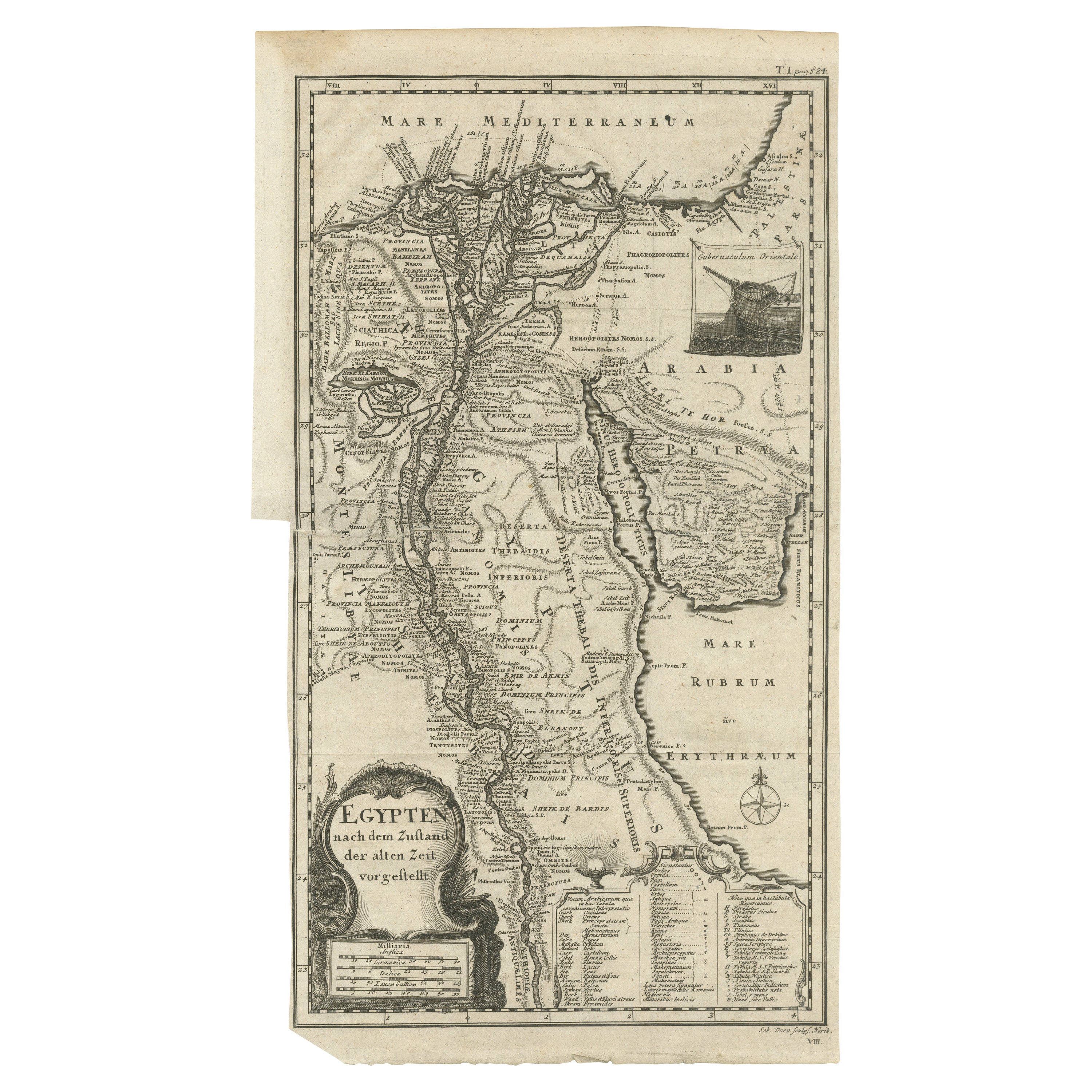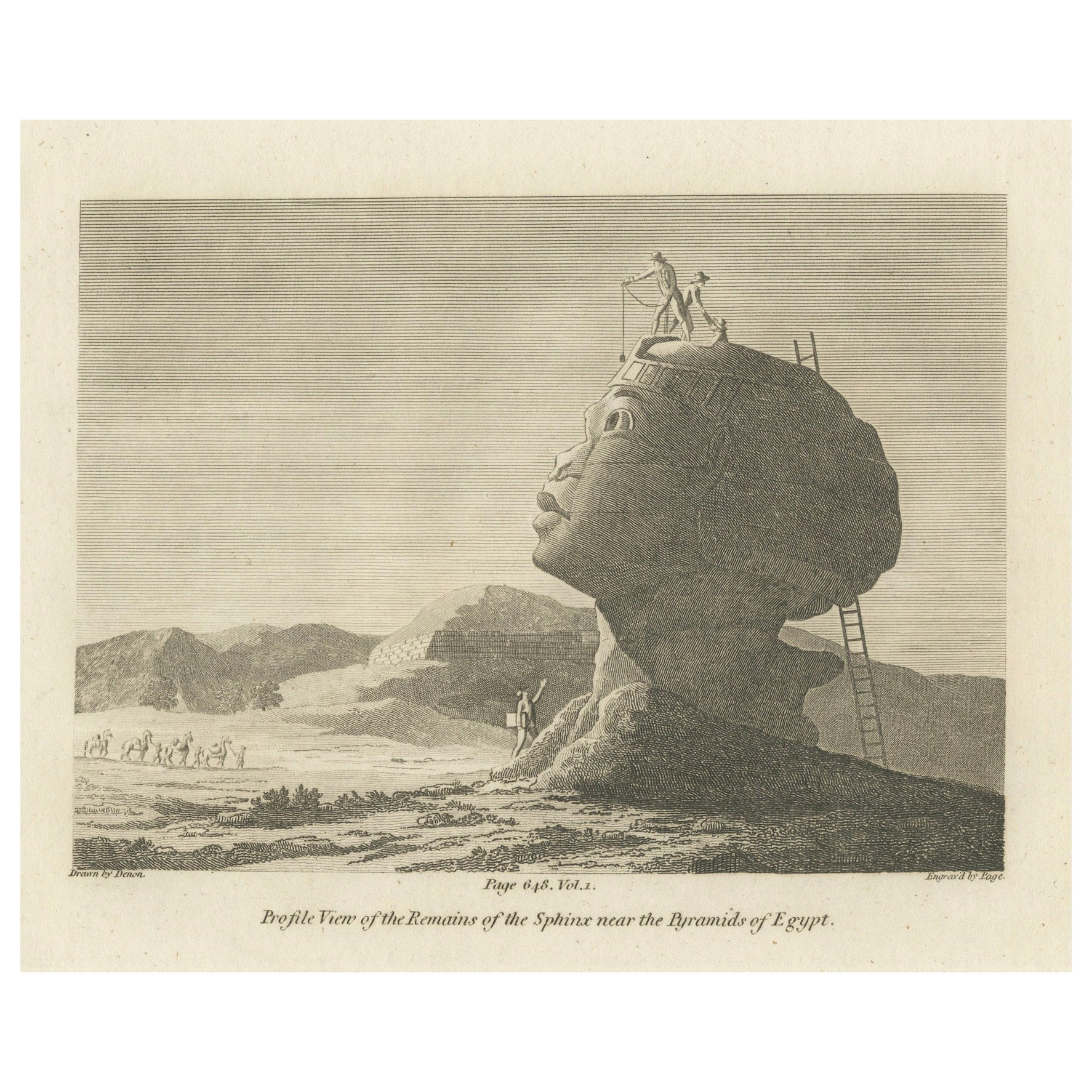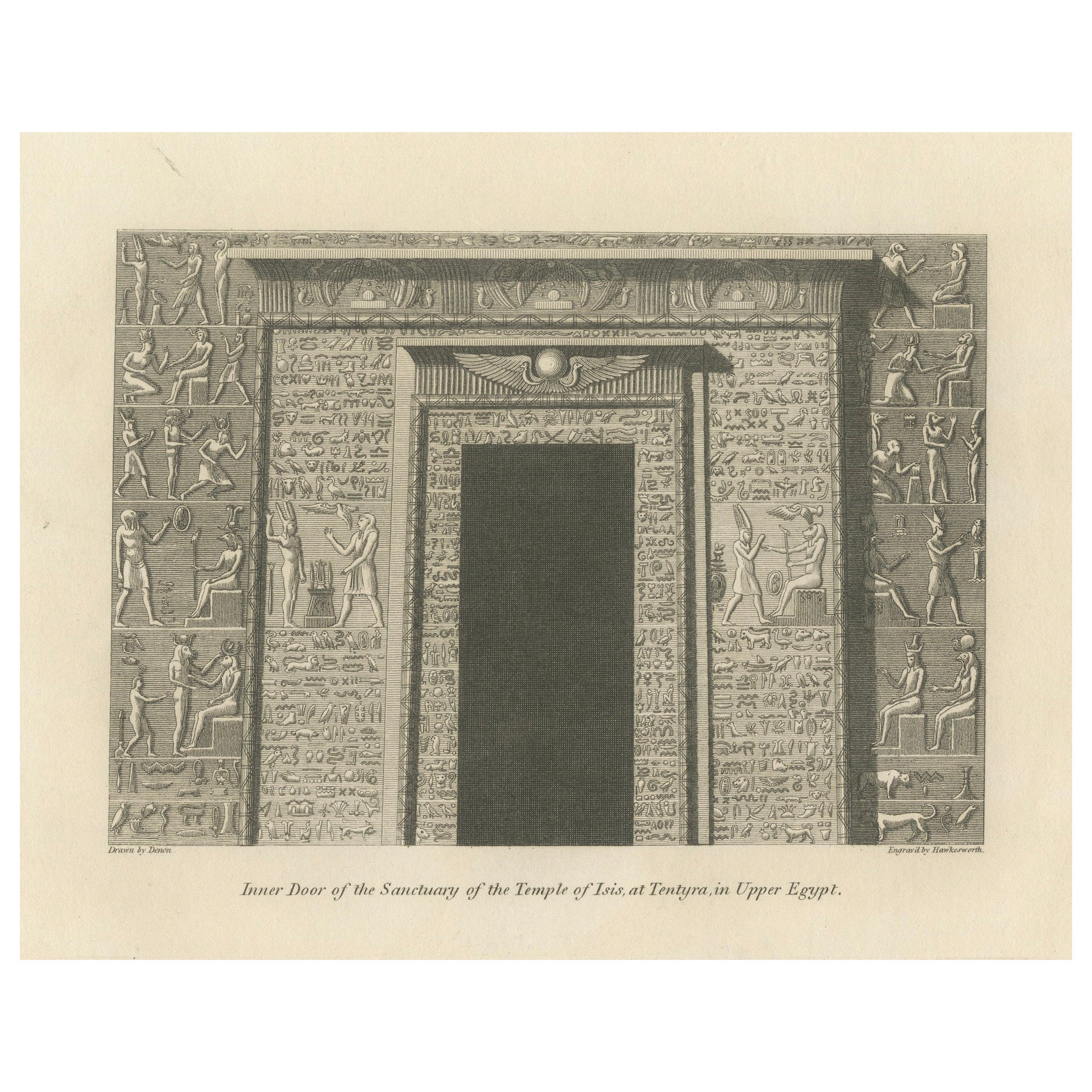Items Similar to Society of the Nile: Mamluk, Lady, and Almee in Egypt, 1801
Want more images or videos?
Request additional images or videos from the seller
1 of 7
Society of the Nile: Mamluk, Lady, and Almee in Egypt, 1801
About the Item
This engraving portrays three distinct figures: an Egyptian Mamluk, an Egyptian lady, and an Almee or dancing girl, representative of Egypt's social diversity. The Mamluk stands prominently, symbolizing military authority, while the women illustrate the cultural and social spheres, with the Almee suggestive of performance arts prevalent in Egyptian culture. Set against the backdrop of the iconic pyramids, this scene captures the essence of 19th-century Egyptian society.
The Mamluks were a warrior class who originated as slave soldiers. They held power in Egypt from the 13th to the early 16th centuries, establishing a sultanate that lasted until the Ottoman conquest. Renowned for their military prowess, the Mamluks successfully defended Egypt against the Mongols and the Crusaders. Their governance was characterized by a complex social and political structure, with a hierarchy based on military achievements and patronage. Despite their slave origins, Mamluks could rise to high positions of power and influence, with many going on to become sultans and governors.
Description: This is a circa 1801 copperplate engraving from George Alexander Cooke's "Universal Geography" .
The print is part of George Alexander Cooke's comprehensive work "A Modern and Authentic System of Universal Geography." This book was a significant compilation of geographical knowledge during the late 18th century, offering descriptions and accounts of various parts of the world, influenced by the age of exploration. It includes narratives of famed explorers like Captain James Cook and Ferdinand Magellan, detailing their discoveries and journeys that expanded the European understanding of the globe. Cooke's work served as both a chronicle and reference for the territories and cultures encountered by these voyagers.
- Dimensions:Height: 7.88 in (20 cm)Width: 10.44 in (26.5 cm)Depth: 0 in (0.02 mm)
- Materials and Techniques:Paper,Engraved
- Period:
- Date of Manufacture:circa 1801
- Condition:Good. Some soiling around the edges due to handling. This is not a reproduction but an original engraving of over 200 years old. Aged paper with typically warm, yellowish-brown hue. Study the image carefully.
- Seller Location:Langweer, NL
- Reference Number:
About the Seller
5.0
Platinum Seller
These expertly vetted sellers are 1stDibs' most experienced sellers and are rated highest by our customers.
Established in 2009
1stDibs seller since 2017
1,947 sales on 1stDibs
Typical response time: <1 hour
- ShippingRetrieving quote...Ships From: Langweer, Netherlands
- Return PolicyA return for this item may be initiated within 14 days of delivery.
More From This SellerView All
- Mamluk Elegance: Military and Ceremonial Attire in Egypt, 1801Located in Langweer, NLThe engraving shows two Mamluks: one in full military attire, and the other, of a higher order, in full ceremonial dress. The detailed illustration captures the distinctiveness of th...Category
Antique Early 1800s Prints
MaterialsPaper
- Antique Map of Egypt and the Nile RiverLocated in Langweer, NLAntique map titled 'Egypten nach dem Zustand der alten Zeit vorgestellt'. This uncommon and richly detailed map of Egypt features hundreds of place names along the Nile. The Sinai Pe...Category
Antique Mid-18th Century Maps
MaterialsPaper
- Silhouette of Antiquity: The Great Sphinx of Giza in Egypt, 1801Located in Langweer, NLThis engraving presents a profile view of the Sphinx, capturing its grandeur alongside the Pyramids of Giza in Egypt. It is a testament to the ancient ...Category
Antique Early 1800s Prints
MaterialsPaper
- Echoes of Thebes: The Luxor Palace Ruins in Upper Egypt, 1801Located in Langweer, NLThe engraving shows the majestic ruins of the Palace of Luxor, located in the village of Luxor near the site of ancient Thebes in Upper Egypt. Luxor was once a flourishing city and t...Category
Antique Early 1800s Prints
MaterialsPaper
- Threshold of Divinity: The Dendera Isis Temple Doorway in Upper Egypt, 1801Located in Langweer, NLThe engraving depicts the intricately carved inner door of the sanctuary of the Temple of Isis located in Tentyra (modern Dendera), Upper Egypt. This temple was dedicated to the godd...Category
Antique Early 1800s Prints
MaterialsPaper
- Original Antique Print with Views of the Nile, EgyptLocated in Langweer, NLAntique print with views of the Nile, Egypt. Below near Damietta. Published by C. de Bruijn, circa 1700. Cornelis de Bruijn (also spelled Cornelius de Bruyn, pronounced (1652 – 17...Category
Antique Early 18th Century Prints
MaterialsPaper
You May Also Like
- Pair of Framed Zoological Prints, Fish of the NileBy Étienne Geoffroy Saint-HilaireLocated in Los Angeles, CAFrance 1805-1812, pair of rare original prints by Etienne Geoffroy de Sant-Hilaire (15 April 1772-19 June 1844) The French zoologist who accompanied Napoleon Bonaparte on his Egyptia...Category
Antique 1810s French Empire Prints
MaterialsPaper, Elm
- Pair of Framed Zoological Prints, Fish of the NileBy Étienne Geoffroy Saint-HilaireLocated in Los Angeles, CAFrance 1805-1812, pair of rare original prints by Etienne Geoffroy de Sant-Hilaire (15 April 1772-19 June 1844) The French zoologist who accompanied Napoleon Bonaparte on his Egyptia...Category
Antique 1810s French Empire Prints
MaterialsElm, Paper
- 2 David Roberts Egypt Lithograph Prints Nile Ferry Gizeh Bazaar Silk MercersBy David RobertsLocated in Dayton, OH"Pair of vintage hand colored lithograph prints by 19th century artist David Roberts, featuring Egyptian scenes, titled “Bazaar of the...Category
Late 20th Century Egyptian Prints
MaterialsPaper
- "The Battle of Bunker's Hill, Near Boston" Engraving by James Mitan, 1801By John TrumbullLocated in Colorado Springs, COThis dramatic Revolutionary War engraving of the Battle of Bunker Hill is after the famous 1785 oil-on-canvas by John Trumbull. Capturing the intensity of the battle, the engraving centers on Major John Small restraining a “lobster-back” from bayoneting Major General Joseph Warren. Warren lies mortally wounded in the midst of chaos around him. In the background, British forces are seen cresting the last defenses of the brave, yet green army of Colonial soldiers. The Battle of Bunker Hill was fought on June 17, 1775, in the early stages of the American Revolutionary War. The battle is named after Bunker Hill in Charlestown, Massachusetts. Although it was the original objective of both the Colonial and British troops, the area was only peripherally involved in the battle. Rather, the majority of the combat took place on the adjacent Breed’s Hill. The battle pitted a more organized British force against a young and inexperienced American militia. Although considered a tactical victory for the British, it came at the cost of considerable casualties, including a large number of officers. The battle demonstrated that the inexperienced American militia was able to stand up to the British army troops in battle. The battle results discouraged the British from any further frontal attacks against well-defended front lines. American casualties were comparatively fewer, although their losses included Gen. Joseph Warren. During the battle, the patriot-turned-painter John Trumbull (1756-1843) was stationed in Roxbury on the far side of Boston, where he could hear the sounds of fighting. In late 1785, Trumbull decided to devote himself to the depiction of Revolutionary War scenes, a series of eight epic pictures. From the beginning, Trumbull intended for the paintings to be later engraved for sale. Trumbull began the oil-on-canvas of The Death of General Warren at the Battle of Bunker’s Hill and The Death of General Montgomery in the Attack of Quebec, in the studio of Benjamin West in London. Bunker’s Hill was completed in March 1786; Trumbull started Attack of Quebec in February 1785 and finished it before he brought it to Paris in 1786. He then started The Declaration of Independence at Thomas Jefferson's house in Paris. As soon as Bunker’s Hill was completed, Trumbull searched for a suitable engraver in London. He was unsuccessful, as many British engravers were nervous about engraving an American battle...Category
Antique Early 1800s English Federal Prints
MaterialsPaper
- Original Antique Print of A Stag, Circa 1801Located in St Annes, LancashireGreat image of a stag Copper-plate engraving Published by Bunny and Gold . Dated 1801 Unframed.Category
Antique Early 1800s English Georgian Prints
MaterialsPaper
- Original Antique Print of The Pyramids of Egypt. C.1820Located in St Annes, LancashireWonderful image of the Pyramids of Egypt Fine copper-plate engraving Published C.1820 Unframed.Category
Antique 1820s English Egyptian Prints
MaterialsPaper





